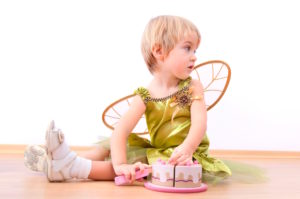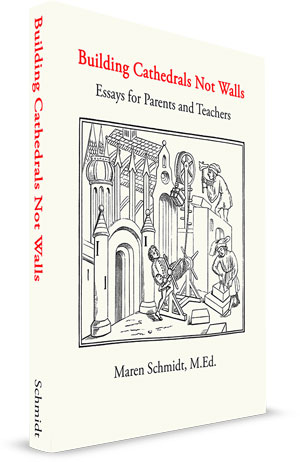
Dear Father, hear and bless thy beasts and singing birds; And guard with tenderness small things that have no words.
Perhaps you remember this childhood prayer. For me it is a call to duty.
Young children often do not have the words to express themselves. I see our job as adults is to help children find expression for their needs and emotions. It is our job to guard with tenderness these eager, loving and trusting children and guide them to become confident and independent adults.
Until children lose their first tooth around age six, they learn very differently than those of us over the age of six. Our biggest teaching mistakes are made by treating these small children as “little adults,” when in fact, they are far from that. One mistake we make is giving our children fantasy when they need something different. Before the age of six, a child has a difficult time perceiving the difference between reality and fantasy because the mind at that point is designed to take in everything as real.
I remember watching Peter Pan on television when I was four years old and believing I could fly off the back of the living room couch. Sound familiar? Reality met fantasy on a hardwood floor, and the goose egg on my forehead was the proof that Peter Pan was fantasy. My disappointment was keen and probably initiated a distrust of television.
Brain research indicates that the violence a child sees on television is taken in by the mind as real. The television violence a child sees before the age of six is undistinguishable to a child’s perception from real acts of violence.
We need to protect our children from make-believe situations that can harm their impressionable minds.
Young children are absorbing information and their minds are creating personal reality from this information. We can help children tremendously by being “storytellers of the truth.”
To a young child a detailed account of what we bought at the grocery store is as interesting as anything we could make up in our wildest dreams. The young child has a hunger for knowing the names of things and seeing how things are done. Around age four-and-a half a child has a strong need for vocabulary and can learn over 250 new words per week if given the opportunity. When language enrichment does not occur, children will create a fantasy world with imaginary friends and activities.
As adults we amuse our children with cartoons and shows with singing animals, vegetables and kitchen appliances. What children need, and can’t tell us, is “real stuff.”
Open up your toolbox, and give your child the names for all the tools. Children love to learn the names of the different parts of each tool. With the hammer, show them the handle, the claw and the head. Tell them it is made of steel.
This is how we become “storytellers of the truth.”
With a healthy diet of facts and experiences, your child will develop a mind based in reality that will aid him or her in developing a reasoning adult mind. Look for a visual dictionary next time you’re in a bookstore. It is full of the names of various items from toothbrushes to airplanes, with labels for all the parts. It’s a better investment for your child’s learning than a new video.
Three- to six-year-olds do not have the knowledge or experience to know what they need to grow. They are “small things that have no words.” Children need adults who will give them a true and realistic picture of the world through meaningful experiences and accurate information.


Great topic!
I would add that the distrust a child feels is directed at much more than the just the television. The betrayal becomes generalized towards the authority figures and culture that continually leads them astray.
Or worse, they refuse to become disloyal or critical of that which they have come to love and respect – and therefore remain unable to clearly distinguish fact from fiction (ripe for pseudoscience, marketers, pundits, politicians, and so on) far into adulthood.
Ted,
Good morning and aloha!
Thanks for adding the idea of trust. Our children trust us.
Offering them accurate and meaningful information and experiences are important ways to build trusting relationships that last a life-time.
I tend to agree with Montessori on the fantasy debate, in general.
But I have to admit, as a 4, 5 year old, I do not remember being confused as to what was real or not when watching Cinderella, cartoons, having fairy tales read to me, etc. Thus, never had the distrust issue regarding that….. I think it can very much depend on the child as well, his/her temperament, personality, family situation. The children in my preschool class discuss what is real or not with interesting accuracy. I grew up in a different era, and today’s kids get a lot more unreality thrown at them. So do adults for that matter.
One of my favorite quotes of hers goes something like this: “The world is so full of such amazing and wonderful things, why would we ever need fantasy.”
Kathy,
Good morning and aloha!
Thanks for sharing.
Not sure I agree with you on this.
According to your theory, we shouldn’t read stories to our child because they are based largely on fantasy. Yet stories feed into our children’s imagination, leading them to a love of reading and creativity.
I’m certainly not going to refrain from reading my little boy Peter Pan – in case he tries to fly. He will learn several lessons by trying – that there is a reality and a fantasy, that gravity can hurt but using your imagination can be fun.
We cannot protect our children from everything. Learning the difference between reality and fantasy is a life lesson, like learning to take risks is also an important life lesson.
As parents we are supposed to be growing independent people, we should be there to kiss it better when they fall from ‘flying’, not restricting their beautiful imaginations in case they get hurt.
Carla,
Good morning and aloha!
My point here is to give our children under the age of six accurate information.
That refers to giving them the correct name of objects and offering an experience and language rich environment.
Around age six, about when the first tooth falls out, we see a profound change in a way a child behaves and takes in information.
The use of the imagination comes into the forefront.
When the young child has been given a diet of accurate information when they are told about the cold of outer space—so could that it makes an ice cube feel hot—they can imagine it.
First, they need experience and language about cold.
And I agree with you, we want to allow for bumps and bruises. Learning occurs at the leading edge of mistakes.
Our children are probably best served by stories like Peter Pan after the age of six, when children are concerned abut moral development, right and wrong, and more.
A link to a Kids Talk article about attachment to reality for the young child is below:
http://marenschmidt.com/2015/05/attachment-to-reality-2/
And about the elementary aged style of learning.
http://marenschmidt.com/2015/01/the-best-years-for-learning-2/
http://marenschmidt.com/2015/01/beware-the-age-of-rudeness/
You might also enjoy my free workshop, Nourishing Creativity In Montessori Environments.
http://marenschmidt.com/workshops/creativity/
Carla, I appreciate you taking the time to write. Thank you!
Makes one think about that Santa or Easter bunny LIE!
When a child figures out they are being lied to about those fantisies, by the very ones they trust, they may give up on the idea of trust all together.
Thanks for voicing this, Maren!
Karen,
The trust our young children give us is tremendous.
And we should not take that gift for granted.
Some people are more literal concrete thinkers and when they find out about the Santa Claus, Easter Bunny, Tooth Fairy myths, they feel deceived.
For me, certain myths convey a deeper story of the human spirit and that’s the story we need to tell our children.
We can choose to use the myths to illustrate a deeper truth.
I think we need to be conscious of why we choose to teach our children certain cultural myths and the bigger story of the human spirit–a story of giving to others, with a bit of surprise, magic, and mystery. A story of striving to make the world a better place, to gladden the hearts of others.
Trust and respect need to be at the core of our relationships.
Thanks for bringing up that point, Karen!
Thanks for this article! My question is: should I tell my 4 year old son Santa Claus does not exist? Should I stop reading fiction books based on fantasy to him?? Thanks a lot!
Widad,
How one wants to approach Santa Claus, the Easter Bunny, and the Tooth Fairy is based on how you see the issue.
For me, using the Santa Claus story is a way to help children understand the magic of giving, the importance of doing “cheerful” work, and having faith that you can get what you desire through intention and effort.
For storytellers, Santa Claus exists as a “real” history and a myth.
For those who have a more black and white perception of the world, the Santa Claus story is one they cannot share with their children. They see it as a lie and a falsehood.
Here is a Kids Talk article about Santa Claus that might share the storyteller’s point of view.
http://marenschmidt.com/2014/12/santa-claus/
Our cultural myths are so strong that it is hard to hide them from children. Around age six, as children enter an age of reasoning, I like to tell them the “Secret of Santa Claus”. The secret is that Santa Claus is people like you and me trying to make the world a better place. Once they know the Secret, the child becomes Santa Claus and learns how have fun giving to others.
That’s my point of view.
There are lots of people that see the Santa Claus myth very different. And that is fine with me.
In terms of books to read.
Here are a couple of book lists to download from my Reading Fundamentals course that help us be “storytellers of the truth”.
Illustrated Book List
Booklist for 3-to-6-Year-Olds
Please let me know if you have any other questions.
Loved the idea and information. A creative mind is a higher priority than information. For information is restricted to all we know and comprehend, while the creative mind accepts the whole world, and all there is at any point will be to know and comprehend.
Mark,
Thank you for sharing your thoughts on the difference between the creative mind and the factual mind.
In my experience, I see that having our feet and heads firmly planted in reality allows us to creatively soar to wherever we can imagine.
To be creative, we need to have the facts.
All the best, Maren